The Blue Heeler goes by a few names – Australian Cattle Dog, ACD, or Cattle Dog.
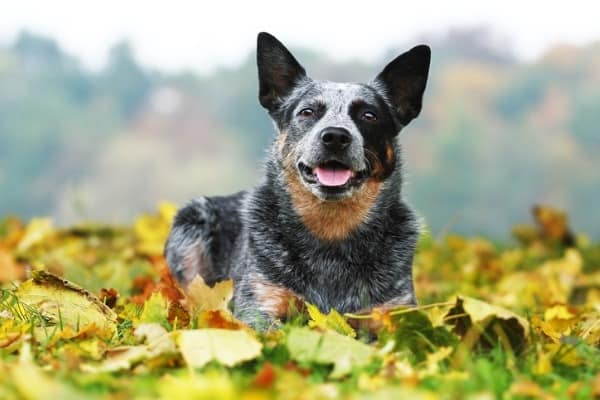
When the Blue Heeler is one-half of a hybrid dog, there are even more interesting titles for them.
You might have heard of a Cowboy Corgis, a Poodle Heeler mix, or a Border Heeler.
These are just a few of several hybrid possibilities.
So what kind of dogs are they?
Do they make good family pets?
Those questions and more will largely depend on what other breed the Blue Heeler hybrid is mixed with.
As long as a dog is half Blue Heeler, some distinct Cattle dog characteristics can shine through.
We’ll cover six popular Blue Heeler mix breeds, how their genetics come into play, and what you can expect if you make one a part of the family.
Lesson 1: Breed Characteristics
Time to learn some fun and important facts about the Blue Heeler and other breeds that can make up this hybrid.
In this article, we’ll explore Blue Heelers mixed with Border Collies, Poodles, German Shepherds, Siberian Huskies, Australian Shepherds, and Labrador Retrievers.
Australian Cattle Dogs
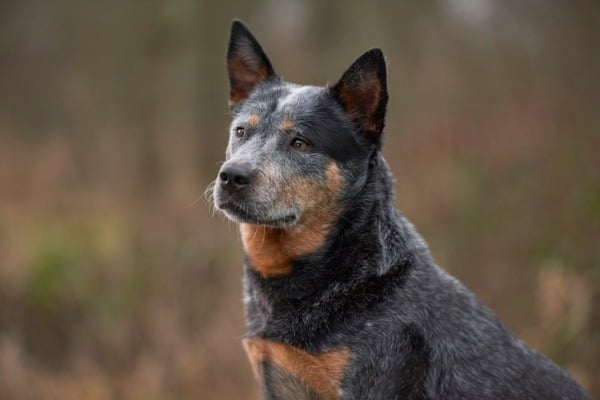
The two varieties of Australian Cattle Dogs – ACDs for short – are Red and Blue Heelers.
They are different in color but are similar in every other way. Bred for herding work, they have origins in Australia – and they even have some dingo DNA.
Their smarts allow them to outwit humans, something they might regularly try if not properly exercised and trained.
That intelligence can make them incredibly fun, rewarding pets to have around.
Being bred to handle the rough conditions of the Australian outback makes them very sturdy as well. Not a lot will phase the Australian Cattle Dog.
The Blue Heeler variety has a signature bluish-colored coat with rust and black accents.
The fur is medium-length and includes an undercoat.
They can weigh up to 50 lbs but are rather stocky and compact – their muscular build means they shine as athletes.
Standard Poodle
Since the miniature and toy varieties of Poodle are so very tiny, you’ll be more likely to encounter a Blue Heeler mixed with a Standard Poodle.
A male Standard Poodle can reach up to 70 lbs, while females are close behind at 50.
They’re not the aristocratic breed that many people think – Poodles of all sizes are very nimble, strong, and excel in agility sports.
They’re also the second smartest dog breed out there. They love people and are considered a very social breed.
Poodles have a fluffy coat that requires quite a bit of care, including regular clips. They come in a rainbow of solid colors – black, white, cream, brown, gray, and many shades in between.
Border Collies
Sorry, Poodles. Border Collies have you beat for the top dog spot in the intelligence rankings.
Another herding breed that originated in Scotland and Wales, where ancient Viking breeds contributed to the Border Collies we see today.
All Border Collies have a double coat, with the hair being more straight and feathery to slightly wavy.
Although several colors are possible, the typical black-and-white combination is most common.
They’re highly popular working dogs and are seen on farms worldwide.
In the right environment, they can make fantastic companion dogs.
The only stipulation?
They have very high exercise needs. This is one of the few breeds who would be unhappy with apartment or city life.
Though they’re compact, weighing around 40-50 lbs, they need ample space to stretch their legs.
German Shepherds
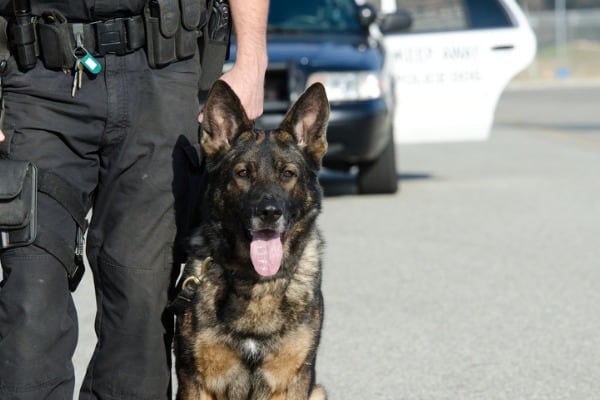
Otherwise known as the GSD, this is another breed that makes the top 5 most intelligent dogs.
Their brainpower makes them highly trainable for a variety of purposes, from military dogs to service animals.
Their size, stoic nature, and standoffishness towards strangers can make them seem scary.
But anyone who has spent time with these lovable dogs knows they are just big sweeties at heart – sometimes to the point that they’re a little wimpy.
That doesn’t stop them from being loyal to the core or forming strong bonds with their families.
Their cuddly tendencies and size can make life interesting for their people – imagine a dog up to 90 lbs trying to curl up in your lap.
Siberian Huskies
Or Sibes, for short, is a working breed known for their beautiful coats and eyes, a penchant for vocalizing, and delightfully dramatic personalities.
They’re big-time shedders – their cold-climate origins mean thick undercoats that shed a lot.
But if you’re willing to put up with “furricanes” in your home, Sibes make very devoted and affectionate pets.
They’re always up for a walk or hike, and cold weather doesn’t stop them from enjoying the outdoors.
Siberian Huskies like to be close to both their human and dog pack members, and like German Shepherds, will park all 60 lbs of themselves right on your legs.
Australian Shepherds
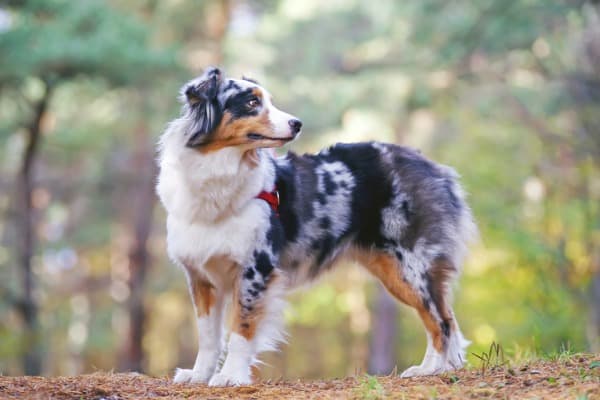
Aussie Shepherds are another herding dog frequently mixed with their Cattle Dog counterparts.
They’re similar to ACDs but have enough differences to make them a separate breed.
As herding dogs, they’re active, mighty, and energetic. They can also be great companions and have less of a stubborn streak than ACDs.
Aside from being popular herding dogs to this day, they can be seen working as therapy or guide dogs.
Their tri-color coats and merle markings make them one of the most unique and eye-catching breeds.
Speaking of eyes, they can be frequently seen with two different colored irises – known as heterochromia.
Labrador Retrievers
Yellow, black, or chocolate labs are water-loving dogs and highly popular family pets.
In fact, they hold the number 1 spot for the most popular dog in America, according to the AKC.
Their gentle, laid-back nature makes them the perfect companion for people of any age.
Labs are friendly and tend to get along with everyone – cats and small pets included.
Their coats are short but thick and water-resistant.
The double coat helps insulate them against cold temperatures and allows them to enjoy cool water for long periods.
Labs are energetic and happily go along with just about any activity.
They were initially bred as sporting dogs and trained to retrieve ducks.
Today, they are often employed as search-and-rescue dogs – a job well suited for their keen noses.
Which Hybrid is Best?
You’ll have to consider the individual health, exercise, and overall care needs of each breed discussed.
Only then can you decide if any Blue Heeler hybrid is a good fit for you.
Ready for more?
We’ll cover some possibilities you might encounter.
Blue Heeler Mix Temperaments
On the Blue Heeler side of the equation, you can expect a highly energetic dog with enough smarts to fool even you.
If you employ early training and proper guidance, Heeler mixes can be your best pal.
But what about the rest?
Blue Heeler Poodle Mix

The intelligence of the Poodle side will only increase the chances you’ll have an ingenious hybrid on your hands.
That highly sociable Poodle parent could pass those friendly characteristics onto their offspring.
It could be the perfect balance for the Heeler’s independent nature.
Border Heelers
A Border Collie and Blue Heeler hybrid will have very high exercise needs.
If those needs are neglected, you could have an anxious, destructive dog on your hands.
The key here is plenty of stimulation – both mental and physical.
Provide that, and you won’t have a defiant or overly hyper dog. You want a Border Heeler, not a Bored-er Heeler.
Again, the high Border Collie IQ will make it very likely this type of hybrid will be incredibly sharp.
Blue Heeler German Shepherd Mix
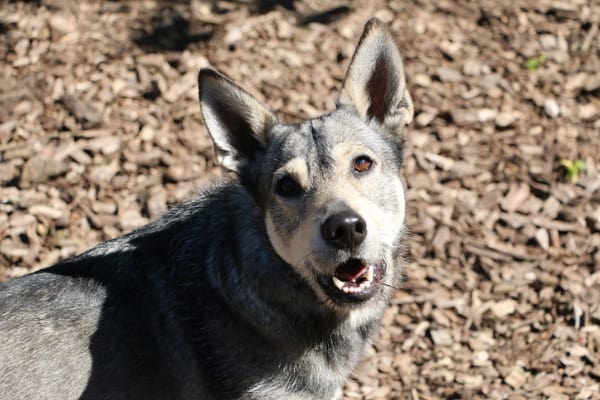
GSDs are another highly intelligent breed, and their willingness to please could make the hybrid very easy to train.
However, they will need consistent training. GSDs can get a little sassy and playful and sometimes need reminders that you mean business.
A gentle and patient hand is very useful in shaping them into an obedient and loyal dog.
Their snuggly side can make them act downright clingy if they’ve been scared (think loud noises).
They’re also easily offended by things like nail clipping or baths and are known to pout for hours if they don’t get their way.
Don’t take it personally – they forgive in the end.
Siberian Heelers
The brassy and dramatic nature of a Sibe could present itself in a Blue Heeler hybrid.
Huskies like to roam, can be stubborn about recalls, and are skilled escape artists.
It might feel like you’re butting heads with a dog who is so willful, but remember, it’s just in their nature.
On the other side of the coin, they can be highly social and friendly.
Once they latch onto the people closest to them, not much will make them back off.
Aussie Shepherd Heeler
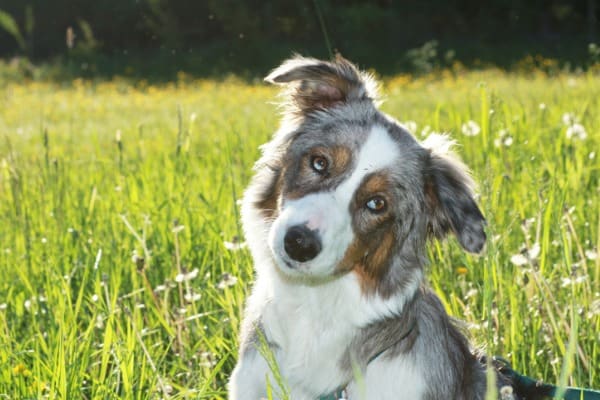
Two dog breeds of similar backgrounds make for a hybrid without many surprising variations – including temperament.
Aussie Shepherds are generally a little more laid back and calm than Blue Heelers.
A hybrid that takes after the shepherd side might be more focused and easier to work with.
Though they could inherit a more relaxed personality, they will still need plenty of exercise. Boredom in this combination is not something you want.
Labrador Heeler
This mix has the potential to be the most easy-going of all others listed.
Labs are quite easy to get along with, eager to please, and love just about everyone they meet.
Labradors aren’t as well known for their intelligence as other breeds mentioned here, but they are far from dumb.
They might take a little longer to train and might be a little uncoordinated.
But they make up for it with their mellow and kind personalities.
They will become very attached to their people – so much so that they could be prone to separation anxiety.
Other mentionable heeler mixes include the Wueensland Heeler mix. the Blue Heeler Hound mix, Blue Heeler Terrier mix, and Golden Retriever Blue Heeler mix.
Training a Blue Heeler Mix Dog
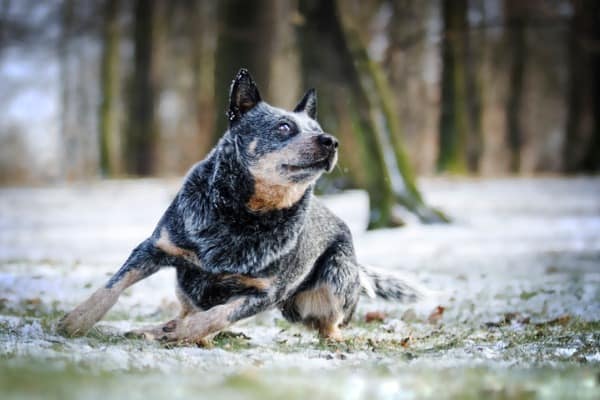
In every possible combination we’ve covered, training should be tackled in the same way.
Some hybrids will take longer to train and need more patience.
Others will learn so fast that you might find they’re a few steps ahead of you.
In either case, consistency is vital.
Be patient, especially with blue heeler mix puppies and things like housetraining.
You want to establish a solid, trusting relationship with yourself and your dog.
Yelling and hitting are never recommended. It teaches fear, which stunts every aspect of your dog’s social development.
Instead, reward, reward, and reward some more. All good behaviors and tasks deserve a treat or even playtime with a favorite toy.
Each of these hybrids has the potential to learn some advanced commands and even cool tricks.
Teaching new things is not only a great way to bond with your dog, but it’s also good for their brains.
The more they learn, the more receptive they will be to learning even more.
Care and Grooming
The specific type of hybrid will greatly influence what your dog will need when it comes to caring.
All breeds discussed here have thick coats and some long hair variations in the mix.
So be prepared for brushing – as often as every day. A shedding rake will be a powerful tool to keep around.
For longer-haired hybrids, brushes designed to prevent matting will be another thing you’ll want to invest it.
As for bathing, dogs who spend more time outdoors will get dirty faster.
If your hybrid is an outdoor enthusiast, you might be looking at baths every few weeks – or whenever they get the urge to play in the mud.
Some of the breeds mentioned here have upright ears.
If the hybrid inherits this trait, more frequent ear cleaning will be needed, as the insides of the ear are more exposed to the elements.
What about feeding?
The size of the hybrid will dictate how much food they’ll need.
Since they all are likely to be active dogs, you can expect to feed them enough to make up for all the energy they burn off.
They’ll need a high-quality and nutrient-dense diet. A few breeds that make up this hybrid, such as Siberian Huskies and GSDs, can be at risk for food allergies.
There could be some trial and error when it comes to finding the ideal food.
Sticking to reputable brands lowers the risk your dog will have a food sensitivity.
It can be on the expensive side, but it can also help avoid a long list of health issues.
So, in the long run, it’s best not to pinch pennies to get the best food.
Blue Heeler Mix Health
Since we’ve covered seven breeds in total, we’ll provide a simple list of each potential health issue they face.
Even in hybrids, these health risks can carry over and present themselves. So here are a few things to look out for.
Blue Heelers
- Hip and Elbow Dysplasia
- Deafness
- Ocular Disorders
Poodles
- Hip Dysplasia
- Ocular Disorders
- Bloat
- Sebaceous Adenitis
Border Collies
- Hip Dysplasia
- Deafness
- Renal Atrophy
- Eye Anomalies
- Trapped Neutrophil Syndrome
German Shepherds
- Hip and Elbow Dysplasia
- Bloat
Siberian Husky
- Hip Dysplasia
- Ocular Disorders
Australian Shepherds
- Hip and Elbow Dysplasia
- Ocular Disorders
Labrador Retrievers
- Hip and Elbow Dysplasia
- Bloat
- Exercise Induced Collapse (EID)
- Ocular Disorders
What’s the takeaway?
You probably noticed that each breed of hip and elbow dysplasia and eye disorders are possible.
Knowing is half the battle, and your vet will more than likely offer testing for these diseases to catch them early if they occur.
Otherwise, knowing that a breeder screened their dogs for genetic conditions before breeding them can help put your mind at ease.
Have a Look at the Blue Heeler Hybrid
What is training a Blue Heeler mix like? What is a Blue Heeler mix puppy like?
Here’s a video that can provide a more in-depth glimpse at what a Blue Heeler Aussie mix looks like and how they respond to training.
What about a Blue Heeler Siberian Husky mix? Have a look!
Are Any of These Hybrids The Right One for You?
Here’s the thing…
Most of these dogs will have intense instincts to herd. Even if their other half isn’t a herding dog, each hybrid we’ve talked about is half Blue Heeler.
If you have small children or other smaller pets, you might want to reconsider this hybrid for your family. This applies to a heeler mix puppy or adult version.
While they can be trained out of their herding behaviors, it will take a lot of time, effort, and patience on your part.
It might also require the help of a professional trainer if their herding instincts are particularly strong.
Heelers get their name from how they nip at the heels of cattle, sheep, or other animals they herd.
They can often fall into this behavior while playing.
There is always a chance a hybrid with Heeler genes could try to corral your small children, cats, farm animals, or even you.
Understand the commitment it would take to break them of that behavior before you commit to one.
Remember, dogs don’t try to herd out of aggression. It’s a result of decades and sometimes centuries of selective breeding.
For many of these breeds, herding is something in their nature. They can’t control it any more than they can control how big they grow.
What else is there to consider?
They will probably have high exercise demands. Use caution if you have a small house; you will need to be willing and able to allow your dog to spend plenty of time outside of it.
If not, you’re running the risk of a bored dog destroying your home from top to bottom.
A dog who is underexercised will also be resistant to training.
Three hours’ worth of walking per day is the minimum time you will need to devote to their physical activity.
An open space for them to run and play fetch would be ideal, and dog parks can be a good substitute for fenced backyards.
They will also need plenty of mental stimulation. These hybrids can do well with car rides, puzzle toys, and even games you can play with them, such as hide-and-seek.
They might also be sensitive to spending too much time alone and can develop separation anxiety.
You could be in for a difficult time if you work long hours or if the dog spends too much time alone.
Make sure your household is prepared to deal with these issues before you commit to one of these hybrids.
If you can spend plenty of time with your dog, have access to open spaces, and a home with no children, they could be the perfect addition to your family.
You have the ideal setup: now, where to find one?
Some of these hybrids are considered designer breeds, and you might find breeders with heeler mix puppies for sale.
A Blue Heeler Australian Shepherd mix is one of the more common hybrids.
Designer dogs don’t come cheap, and they’re frequently offered by backyard breeders.
Be careful when choosing a heeler mix puppy- it’s best to find a breeder who has provided health screenings for all dogs involved.
A certificate of health should come with heeler mix puppies.
An even better option?
Get in touch with rescues and shelters that often have hybrids up for adoption.
The fees will be lower, and you’ll be giving a home to a dog who needs one without falling prey to irresponsible breeders.
When you commit the time and energy, it takes to raise Blue Heeler mix dogs; they can be incredible pets and even better friends.
One Blue Heeler, Many Possibilities
The list of hybrids we’ve covered is by no means exhaustive – but hopefully, it’s given you a better idea about what’s out there and if one is the dog for you.
Any Australian Cattle Dog mix will be a dog that requires a lot of your time.
For some people, that’s precisely what they’re looking for in a dog.
ACD hybrids will be your best walking and running pal. Some of the hybrids here might make for a good swimming buddy, agility dog, or guard for your livestock as well.
One thing is for sure, regardless of what breed the ACD is mixed with – when you love your blue heeler mix, they will love you back.
You’ll have an adoring fan who loves to please and sticks by your side.
